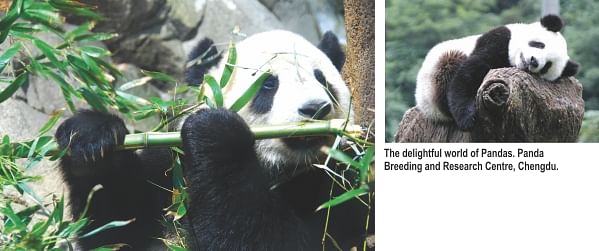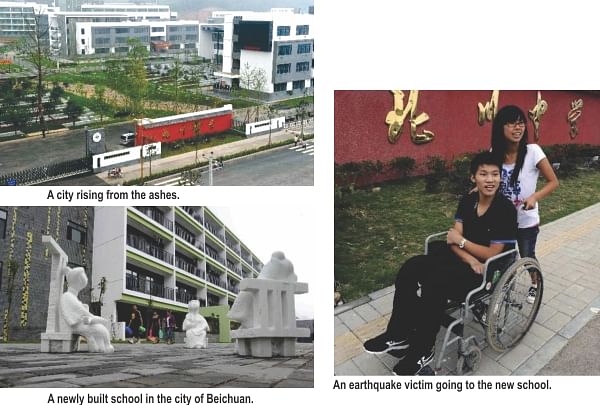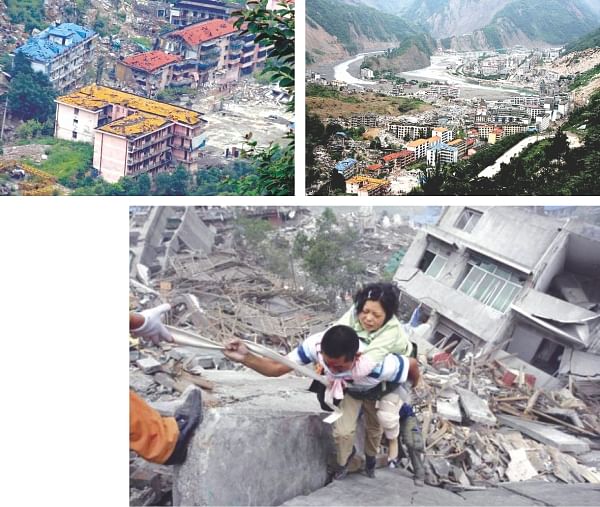| Home - Back Issues - The Team - Contact Us |
 |
| Volume 10 |Issue 34 | September 09, 2011 | |
|
|
Reflections
From an Ancient City to Dr Salehuddin Ahmed A workshop on disaster risk management brought us to the picturesque city of Chengdu. It was a 10-day workshop attended by about 20 participants, mid- and senior-level government officials from 14 Asian and Pacific countries, two of whom were from the Bangladesh government. Chengdu is the capital of the Heavenly State (Tian Fu Zhi Guo) of Sichuan. As you may know, Sichuan is the habitat of the famous panda, and rose hibiscus. Chengdu covers an area of 12.3 thousand square kilometres (4,749 square miles) with a population of over 12 million. In Chengdu we visited the historical irrigation project, Dujiangyan, which was built in 256 B.C. It was hard to believe how this gigantic project could be built in those days. To stop flooding of the area and the city, a big river was bifurcated into two with a dam which looks like a fish tail. We had to climb a considerable height to observe the fish tail. It was simply awesome. Anybody visiting Chengdu must not miss this great feat of the Chinese people.
The history of Chengdu can be traced back 2,400 years when the first emperor built his capital here and named the city. Through thousands of years its original name has been kept. Since the Han (206-220 BC) and Tang (618-907) Dynasties when its handicraft industry flourished, Chengdu has been famous for its brocades and embroidery. 'Shu' embroidery still enjoys a high reputation for its bright colours and delicate designs, ranking among the four main types of embroidery in China. Intricately designed, primarily by women, they are simply beautiful and it is hard to believe that they are done by hand. It was a pleasure to visit the Panda Breeding and Research Centre, located in a huge sprawling park with lakes and gardens. We saw several pandas of different age groups. They were so cute! Pandas are generally very lazy animals. They only eat bamboo shoots and leaves, nothing else, and sleep most of the time. It was fun to see giant pandas playing and lounging around. Other places of importance and interest in Chengdu are The Thatched Cottage of Du Fu, Wuhou Memorial Temple and Wenshu Monastery. Natural beauty abounds in surrounding areas of Chengdu. As a part of the workshop there were also field visits to the townships of Wenchuan and Beichuan which were most seriously affected by the disastrous earthquake of 2008. My wife and I went with the group of participants to see Beichuan. We went by bus to a small city of Meiyang. It was about two hours from Chengdu. Then we were taken by another bus to Beichuan again about an hour from there.
Beichuan was a small town of 160,000 people, nestling in one of the world's most wonderful valleys. A beautiful river criss-crossed the town. Out of this population about 50,000 people lost their lives and the township was totally destroyed and the people there suffered unimaginable devastation and despair. We were first taken to see the destroyed city. It was a very touching scene. We could see in front of our eyes the devastated township now unfit for living. Then we were taken to a new city, which was not very far. It was amazing to see that the newly built city of Beichuan with wide roads, memorials, commercial and entertainment centres, many multistoried housing complexes. We were overwhelmed to see this beautiful modern city which was built in only 18 months. And it was an example of extraordinary cooperation and support from people of another province. 30,000 engineers, architects, professionals, workers came from the Shandong Province and built this whole new city from scratch, for the survivors of the earthquake and then they went back. What an example of solidarity. The city was as good as any other sophisticated city in any part of the world. We walked around, paid our respects in front of the memorial, which was beautiful and in a big area with a park. We also visited the apartment buildings. We entered a small apartment, it was hardly 60 or 70 square metres, with two small bedrooms and all other modern amenities. After visiting the earthquake affected areas we came back and had the concluding session of the workshop. Participants narrated their impressions about the earthquake stricken areas and also commented on the meaningful and great work done by the Chinese government and people in rehabilitating the victims of the devastating earthquake of 2008. The writer is Chief Technical Advisor, International Poverty Reduction Centre, Beijing, China.
Copyright
(R) thedailystar.net 2011 |


